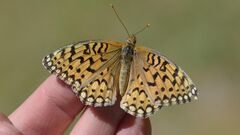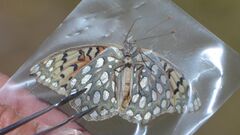Biology:Speyeria callippe
| Callippe fritillary | |
|---|---|

| |
| S. c. callippe | |
| Scientific classification | |
| Domain: | Eukaryota |
| Kingdom: | Animalia |
| Phylum: | Arthropoda |
| Class: | Insecta |
| Order: | Lepidoptera |
| Family: | Nymphalidae |
| Genus: | Speyeria |
| Species: | S. callippe
|
| Binomial name | |
| Speyeria callippe (Boisduval, 1852)
| |
| Synonyms | |
| |
Speyeria callippe, the callippe fritillary, is a North American species of butterflies in the brush-footed family Nymphalidae.
Subspecies
Listed alphabetically:[2]
- S. c. calgariana (McDunnough, 1924)
- S. c. callippe Boisduval, 1852
- S. c. comstocki (Gunder, 1925) – Comstock's silverspot
- S. c. elaine dos Passos & Grey, 1945
- S. c. gallatini (McDunnough, 1929)
- S. c. harmonia dos Passos & Grey, 1945
- S. c. juba (Boisduval, 1869)
- S. c. laura (Edwards, 1879)
- S. c. laurina (Wright, 1905)
- S. c. liliana (H. Edwards, 1877)
- S. c. nevadensis (Edwards, 1870)
- S. c. macaria (Edwards, 1877)
- S. c. meadii (Edwards, 1872)
- S. c. rupestris (Behr, 1863)
- S. c. semivirida (McDunnough, 1924)
- S. c. sierra dos Passos & Grey, 1945
Distribution and habitat
This species can be found in North America, from Central British Columbia east to South Dakota and Manitoba, south to southern California , Nevada, Utah, and Colorado. These butterflies usually inhabit sagebrush, dry woodland, edge of forests, chaparral and grassy hillsides.[3][4]
Description
Speyeria callippe can reach a wingspan of 5–6.4 cm (2.0–2.5 in). In these large and widespread butterflies the color of the upperside of the wings varies from tawny to bright red-brown with black evenly-spaced zigzag stripes. The entire outer contour is black-brown, divided by a row of pale lunules. The underside of the forewings is red fawn, with the same design as above, and a series of marginal silver lunules. The underside of the hindwings is brown, with about twenty-two large silvered spots and triangular silver submarginal spots with narrow brown edges.[1][3] In the last stage the larvae are greyish, with black and grey patches and black-orange spines. [5][6]
Biology
Speyeria callippe is a univoltine species. Adults fly from May to August, usually patrolling for females, which emerge before males. Eggs are laid in litter near the host plants. Unfed first-stage caterpillars overwinter until spring, when they feed on leaves of Viola pedunculata, Viola nuttallii, Viola beckwithii, Viola douglasii and Viola purpurea.[3][2]
Gallery
References
| Wikimedia Commons has media related to Speyeria callippe. |
- ↑ 1.0 1.1 M. L. Dufour Annales de la Société entomologique de France (in French)
- ↑ 2.0 2.1 "Speyeria Scudder, 1872" at Markku Savela's Lepidoptera and Some Other Life Forms
- ↑ 3.0 3.1 3.2 Butterflies and Moths of North America
- ↑ iNaturalist
- ↑ Ross A. Layberry, Peter W. Hall, J. Donald Lafontaine The Butterflies of Canada
- ↑ Thomas J. Allen, Jim P. Brock, James P. Brock, Jeffrey Glassberg Caterpillars in the Field and Garden: A Field Guide to the Butterfly of North America
External links
Wikidata ☰ Q7576455 entry
 |




